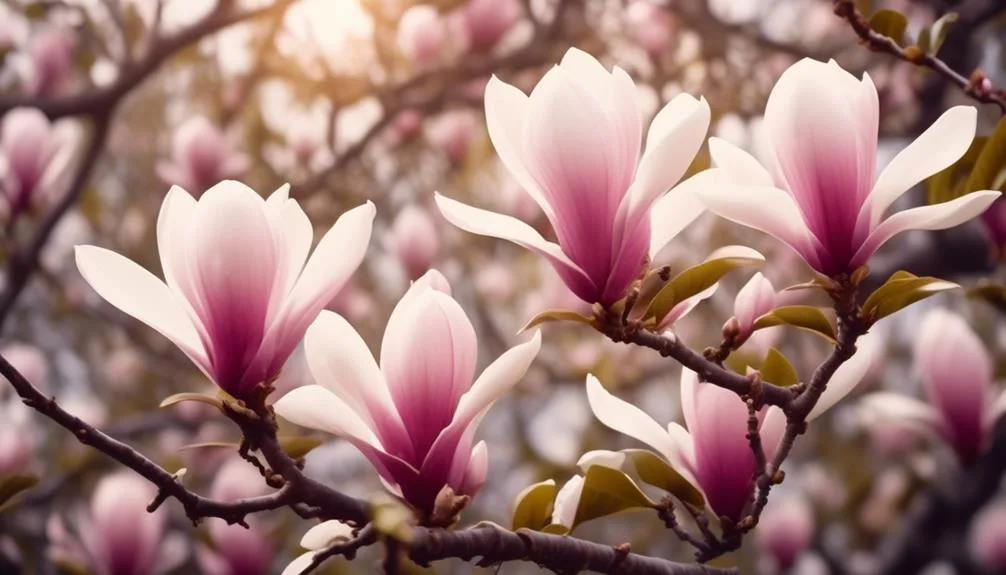Ever wondered why magnolia trees have such big flowers? The reason is a mix of biology and survival strategy.
These flowers aren't just for show; they play a vital role in the tree's existence. The mystery of their size and shape reveals a story of adaptation and resilience.
Understanding this sheds light on the factors that have influenced the magnolia tree's beautiful blossoms.
Evolutionary Purpose
The large, showy flowers of magnolia trees serve an evolutionary purpose, attracting pollinators such as beetles and flies with their strong fragrance and nectar. This reproductive advantage is closely linked to the floral morphology of magnolias, which has coevolved with specific pollinators over time.
The unique shape, size, and color of magnolia flowers have developed through coevolutionary relationships with their pollinators, ensuring successful pollination and the continuation of their species. These ecological interactions between magnolia trees and their pollinators have led to a mutualistic relationship, where both parties benefit.
As the beetles and flies feed on the nectar and inadvertently transfer pollen from one flower to another, magnolia trees are able to reproduce and propagate, ensuring their survival in their natural habitats.
Pollination Strategy
Attracting pollinators with their strong fragrance and nectar, the magnolia trees' pollination strategy relies on a coevolutionary relationship with specific insects, ensuring successful reproduction and propagation.
The floral morphology of magnolia flowers, with their large, showy petals and sturdy, cone-like structures, is designed to attract pollinators such as beetles and flies. The robust nature of the flower allows these insects to land and move around easily, increasing the chances of pollen transfer.
Furthermore, the production of abundant nectar serves as a reward for the visiting insects, encouraging them to visit more flowers and facilitate cross-pollination.
This specialized strategy plays a crucial role in the magnolia tree's reproductive success, as it ensures the transfer of pollen between flowers, leading to the development of seeds and ultimately the propagation of new magnolia trees.
Environmental Adaptation
Adapting to diverse climates and soil conditions, magnolia trees demonstrate remarkable resilience in the face of environmental challenges, showcasing their ability to thrive in varying landscapes. This climate resilience allows them to endure harsh winters and scorching summers, ensuring their survival in a wide range of conditions. Their soil adaptation enables them to grow in both acidic and alkaline soils, further expanding their habitat range.
Magnolia trees' ability to bloom in different seasons not only adds aesthetic value to the environment but also provides crucial resources for various pollinators, supporting the delicate balance of ecosystems.
The large, showy flowers of magnolia trees give them a reproductive advantage by attracting a diverse array of pollinators, ensuring successful pollination and genetic diversity within the species.
Their adaptability to environmental stressors demonstrates the resilience and tenacity of magnolia trees, serving as a testament to the wonders of nature's evolutionary processes.
Genetic Factors
Demonstrating a remarkable diversity of genetic traits, magnolia trees exhibit a wide spectrum of characteristics that contribute to their resilience and adaptability.
Their large flowers are a result of genetic inheritance and complex floral development processes. Through generations, genetic inheritance has played a crucial role in shaping the size, color, and structure of magnolia flowers.
Various genetic factors, such as gene mutations and selective breeding, have influenced the development of these remarkable floral displays. The genes responsible for floral development in magnolia trees have undergone natural selection, leading to the evolution of their strikingly large and visually captivating flowers.
Understanding the genetic factors behind the development of magnolia flowers provides valuable insights into the intricate mechanisms that drive the diversity and beauty of these iconic trees.
Horticultural Significance
The horticultural significance of magnolia trees lies in their ability to thrive in various climates and soil conditions, making them a popular choice for gardens and landscapes. Their remarkable horticultural appeal stems from their ability to create a stunning floral display that captivates the senses.
Here's why magnolia trees hold such significance in horticulture:
- Breathtaking Floral Display: Magnolia trees produce large, showy flowers that range in color from creamy white to rich pink and purple, creating a breathtaking floral display that adds an enchanting allure to any garden or landscape.
- Versatile Landscaping: Their adaptability to different climates and soil types makes them a versatile choice for landscaping, allowing homeowners and horticulturists to enjoy their beauty in a wide range of settings.
- Historical Significance: Magnolia trees have a rich history and cultural significance, making them not just a horticultural marvel, but also a symbol of tradition and heritage.
Conclusion
In the world of plant evolution, magnolia trees' large flowers are a testament to their intricate adaptation and purposeful design.
Their beauty not only attracts pollinators but also reflects millions of years of evolution.
Whether in the wild or in our backyards, these magnificent blooms offer a glimpse into the fascinating and resilient nature of the natural world.

My interest in trees started when I first saw the giant sequoias in Yosemite.
I was a teenager then, and I remember thinking, “I need to learn more about this.”
That moment stuck with me.
A few years later, I went on to study forestry at Michigan Tech.
Since graduating, I’ve worked in a mix of hands-on tree care and community education.
I’ve spent over ten years helping people understand how to plant, maintain, and protect the trees in their neighborhoods.
I don’t see trees as just part of the landscape.
They are living things that make a real difference in our daily lives.
